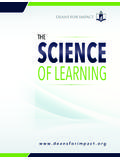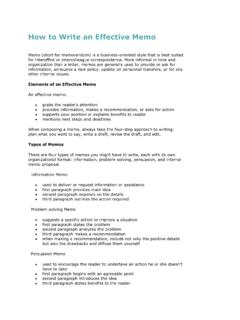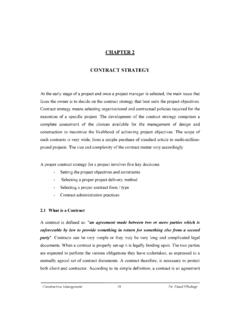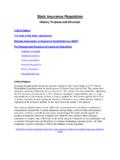Transcription of SCIENCETHE - Deans for Impact
1 THE. SCIENCE. OF LEARNING. About THE SCIENCE OF LEARNING. T he purpose of The Science of Learning is to summarize the existing research from cognitive science related to how students learn, and connect this research to its practical implications for teaching and learning. This document is intended to serve as a resource to teacher-educators, new teachers, and anyone in the education profession who is interested in our best scientific understanding of how learning takes place. This document identifies six key questions about learning that should be relevant to nearly every educator. Deans for Impact believes that, as part of their preparation, every teacher- candidate should grapple with and be able to answer the questions in The Science of Learning.
2 Their answers should be informed and guided by the existing scientific consensus around basic cognitive principles. And all educators, including new teachers, should be able to connect these principles to their practical implications for the classroom (or wherever teaching and learning take place). The Science of Learning was developed by member Deans of Deans for Impact in close collaboration with Dan Willingham, a cognitive scientist at the University of Virginia, and Paul Bruno, a former middle-school science teacher. We are greatly indebted to the reviewers who provided thoughtful feedback and comments on early drafts, including cognitive scientists, teacher-educators, practicing teachers, and many others.
3 The Science of Learning does not encompass everything that new teachers should know or be able to do, but we believe it is part of an important and evidence-based core of what educators should know about learning. Because our scientific understanding is ever evolving, we expect to periodically revise The Science of Learning to reflect new insights into cognition and learning. We hope that teachers, teacher-educators, and others will conduct additional research and gather evidence related to the translation of these scientific principles to practice. The present version of this document may be cited as: Deans for Impact (2015). The Science of Learning. Austin, TX: Deans for Impact .
4 About Deans FOR Impact . F ounded in 2015, Deans for Impact is a national nonprofit organization representing leaders in educator preparation who are committed to transforming educator preparation and elevating the teaching profession. The organization is guided by four key principles: Data-informed improvement;. Common outcome measures;. Empirical validation of effectiveness; and Transparency and accountability for results. More information on the organization and its members can be found on the Deans for Impact website. THE SCIENCE OF LEARNING. 1 HOW DO STUDENTS UNDERSTAND NEW IDEAS? COGNITIVE PRACTICAL IMPLICATIONS. PRINCIPLES FOR THE CLASSROOM. Students learn new ideas by A well- sequenced curriculum is important to ensure that students have the reference to ideas they already prior knowledge they need to master new Teachers use analogies because they map a new idea onto one that students already know.
5 But analogies are effective only if teachers elaborate on them, and direct student attention to the crucial similarities between existing knowledge and what is to be To learn, students must transfer Teachers can use worked examples as one method of reducing students'. information from working cognitive A worked example is a step- by- step demonstration of memory (where it is consciously how to perform a task or solve a problem. This guidance or scaffolding . processed) to long- term can be gradually removed in subsequent problems so that students are memory (where it can be required to complete more problem steps independently. stored and later retrieved). Teachers often use multiple modalities to convey an idea; for example, they Students have limited working will speak while showing a graphic.
6 If teachers take care to ensure that the memory capacities that can be two types of information complement one another such as showing an overwhelmed by tasks that are animation while describing it aloud learning is enhanced. But if the two cognitively too demanding. sources of information are split such as speaking aloud with different text Understanding new ideas can displayed visually attention is divided and learning is be impeded if students are Making content explicit through carefully paced explanation, modeling, confronted with too much and examples can help ensure that students are not information at (Note: explanation does not mean teachers must do all the talking.)
7 Cognitive development does Content should not be kept from students because it is developmentally not progress through a fixed inappropriate. The term implies there is a biologically inevitable course sequence of age- related stages. of development, and that this course is predictable by age. To answer the The mastery of new concepts question is the student ready? it's best to consider has the student happens in fits and mastered the prerequisites? 9. 1. Bransford, Brown, & Cocking, 2000 5. Pashler, Bain, Bottge, Graesser, 7. Kirschner, Sweller, & Clark, 2006;. 2. Agodini, Harris, Atkins- Burnett, Koedinger, & McDaniel, 2007; Kirschner, TeachingWorks Heaviside, Novak, & Murphy, 2009; Sweller, & Clark, 2006; Atkinson, Derry, 8.
8 Flynn, O'Malley, & Wood, 2004;. TeachingWorks Renkl, & Wortham, 2000; Sweller, 2006 Siegler, 1995. 3. Richland, Zur, & Holyoak, 2007 6. Chandler & Sweller, 1992; Moreno & 9. Willingham, 2008. 4. Sweller, 1988 Mayer, 1999; Moreno, 2006. THE SCIENCE OF LEARNING. 2 HOW DO STUDENTS LEARN AND RETAIN. NEW INFORMATION? COGNITIVE PRACTICAL IMPLICATIONS. PRINCIPLES FOR THE CLASSROOM. Information is often Teachers can assign students tasks that require explanation ( , answering withdrawn from memory just questions about how or why something happened) or that require students as it went in. We usually want to meaningfully organize material. These tasks focus students' attention on students to remember what the meaning of course information means and why it is important, so they should Teachers can help students learn to impose meaning on hard-to-remember think about meaning when they content.
9 Stories and mnemonics are particularly effective at helping students do encounter to-be-remembered Practice is essential to learning Teachers can space practice over time, with content being reviewed across new facts, but not all practice is weeks or months, to help students remember that content over the long- equivalent. 13 Teachers can explain to students that trying to remember something makes memory more long-lasting than other forms of studying. Teachers can use low- or no-stakes quizzes in class to do this, and students can use Teachers can interleave ( , alternate) practice of different types of content. For example, if students are learning four mathematical operations, it's more effective to interleave practice of different problem types , rather than practice just one type of problem, then another type of problem, and so 10.
10 Morris, Bransford, & Franks, 1977 12. Peters & Levin, 1986 15. Agarwal, Bain, & Chamberlain, 11. McDaniel, Hines, Waddill, & Einstein, 13. Ericsson, Krampe, & Tesch-R mer, 2012; Pashler, Bain, Bottge, Graesser, 1994; Rosenshine, Meister, & Chapman, 1993 Koedinger, & McDaniel, 2007. 1996; Graesser & Olde, 2003; 14. Cepeda, Pashler, Vul, Wixted, & Rohrer, 16. Pashler, Bain, Bottge, Graesser, TeachingWorks 2006; Pashler, Bain, Bottge, Graesser, Koedinger, & McDaniel, 2007; Rohrer, Koedinger, & McDaniel, 2007 Dedrick, & Stershic, 2015. THE SCIENCE OF LEARNING. 3 HOW DO STUDENTS SOLVE PROBLEMS? COGNITIVE PRACTICAL IMPLICATIONS. PRINCIPLES FOR THE CLASSROOM. Each subject area has some Teachers will need to teach different sets of facts at different ages.






